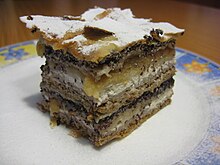
Prekmurje is a geographically, linguistically, culturally and ethnically defined region of Slovenia, settled by Slovenes and a Hungarian minority, lying between the Mur River in Slovenia and the Rába Valley in the westernmost part of Hungary. It maintains certain specific linguistic, cultural and religious features that differentiate it from other Slovenian traditional regions. It covers an area of 938 square kilometers (362 sq mi) and has a population of 78,000 people.
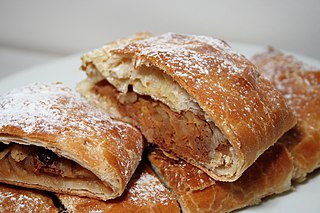
Apple strudel is a traditional Viennese strudel, a popular pastry in Austria, Bavaria, the Czech Republic, Northern Italy, Slovenia, Croatia, and other countries in Europe that once belonged to the Austro-Hungarian Empire (1867–1918).

Filo or phyllo is a very thin unleavened dough used for making pastries such as baklava and börek in Middle Eastern and Balkan cuisines. Filo-based pastries are made by layering many sheets of filo brushed with oil or butter; the pastry is then baked.

A strudel is a type of layered pastry with a filling that is usually sweet, but savoury fillings are also common. It became popular in the 18th century throughout the Habsburg Empire. Strudel is part of Austrian cuisine and German cuisine but is also common in other Central European cuisines. In Italy it is recognized as a traditional agri-food product (PAT) of South Tyrol.
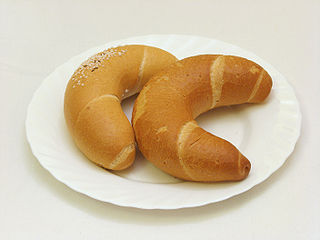
Kifli, kiflice, kifle, or kipferl is a traditional yeast bread roll that is rolled and formed into a crescent before baking.

Buchteln are sweet rolls made of enriched yeast dough, filled with powidl, jam, chocolate, ground poppy seeds or quark, brushed with butter and baked in a large pan so that they stick together and can be pulled apart. The traditional buchtel is filled with powidl. Buchteln may be topped with vanilla sauce, powdered sugar or eaten plain and warm. Buchteln are served lukewarm, mostly as a breakfast pastry or with tea. In the 19th century they could be boiled similar to dumplings.

Banitsa, also transliterated as banica and banitza, is a traditional pastry made in Bulgaria. It is also made in Budjak, where it is known as milina by Ukrainian Bulgarians; North Macedonia; and southeastern Serbia. In southeastern Serbia, it may also be known as gibanica. Banitsa is prepared by layering a mixture of whisked eggs, plain yogurt, and pieces of white brined cheese between filo pastry and then baking it in an oven.

Börek or burek is a family of pastries or pies found in the Balkans, Middle East and Central Asia. The pastry is made of a thin flaky dough such as filo with a variety of fillings, such as meat, cheese, spinach, or potatoes. Boreks are mainly associated with the Middle East, Armenia, and also with the former Ottoman Empire, including the Balkans and the South Caucasus, Eastern European and Central European countries, Northern Africa and Central Asia. A borek may be prepared in a large pan and cut into portions after baking, or as individual pastries. They are usually baked but some varieties can be fried. Borek is sometimes sprinkled with sesame or nigella seeds, and it can be served hot or cold.

Pastilla is a North African meat or seafood pie made with warqa dough (ورقة), which is similar to filo. It is a speciality of Morocco, Algeria, and Tunisia, where its variation is known as malsouka. It has more recently been spread by emigrants to France, Israel, and North America.

Gibanica is a traditional pastry dish popular all over the Balkans. It is usually made with cottage cheese and eggs. Recipes can range from sweet to savoury, and from simple to festive and elaborate multi-layered cakes.
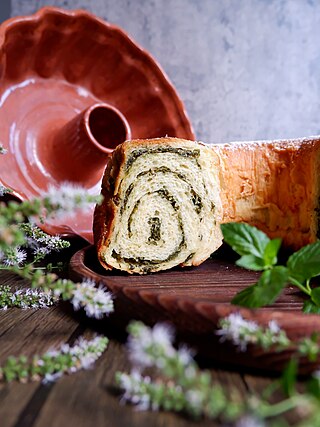
Potica is a traditional festive pastry from Slovenia.
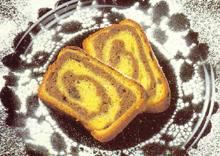
A nut roll is a pastry consisting of a sweet yeast dough that is rolled out very thin, spread with a nut paste made from ground nuts and a sweetener like honey, then rolled up into a log shape. This 'log' is either left long and straight or is often bent into a horseshoe shape, egg washed, baked, and then sliced crosswise. Nut rolls resemble a jelly roll but usually with more layers of dough and filling, and resemble strudels but with fewer and less delicate dough layers. Fillings commonly have as their main ingredient ground walnuts or poppy seeds.

Slovenian cuisine is influenced by the diversity of Slovenia's landscape, climate, history and neighbouring cultures. In 2016, the leading Slovenian ethnologists divided the country into 24 gastronomic regions. The first Slovene-language cookbook was published by Valentin Vodnik in 1798.
Belokranjska povitica is a Slovenian national dish. It was supposedly brought to the White Carniola region by the Uskoks, who were Croatian Habsburg soldiers that inhabited the areas of the eastern Adriatic area. The name itself, povitica, explains the preparation. The term povitica derived from the verb poviti 'to roll'.
Bujta repa is a Slovene national dish. It was mostly made in Prekmurje, the northeastern part of Slovenia. The expression bujta comes from the verb form bujti. The dish was originally relished in winter at pig slaughter or koline.

Baklava is a layered Middle Eastern dessert made of filo pastry sheets, filled with chopped nuts, and sweetened with syrup or honey. It was one of the most popular sweet pastries in the Ottoman Empire.

The poppy seed roll is a pastry consisting of a roll of sweet yeast bread with a dense, rich, bittersweet filling of poppy seed. An alternative filling is a paste of minced walnuts, or minced chestnuts.

Međimurska gibanica(pronounced[mɛdʑǐmuːrska'ɡibaŋitsa]; Međimurian layer cake) is a type of gibanica or layer cake originating from Međimurje County, Croatia. It is made of puff pastry and four fillings: nuts, fresh cheese, poppy seeds and apples, as well as of many additional ingredients. It is a traditional dish, especially popular in Northern Croatia, rich in flavour and full of calories, a delicacy which is an integral component of Croatian cuisine.

Štruklji is a traditional Slovene dish, composed of dough and various types of filling. The dish comes in the form of rolled dumplings, which can be steamed, boiled, or baked, and can have a wide range of fillings. Štruklji has been traditionally reserved for special occasions, but is now one of the most characteristic everyday dishes in households all across Slovenia. It is closely related to Zagorski štrukli, a traditional Croatian dish.
